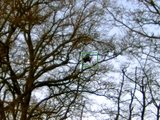Boeing Defence Australia to support RAAF Wedgetail
Boeing Defence Australia (BDA) has assumed responsibility for the sustainment of the Royal Australian Air Force E-7A Wedgetail Airborne Early Warning & Control (AEW&C) fleet under a new contract modification announced on 30 July. The role was previously carried out by Boeing in the US.
Under the contract BDA will now execute the E-7A Wedgetail In-Service Support Performance-Based Logistics contract, and ensure the continued high level of readiness for the RAAF’s command and control aircraft fleet. Other Boeing organisations will act as subcontractors.
Shelley Lavender, vice president and general manager of Boeing Integrated Logistics, said: ‘This change effectively combines Boeing’s knowledge as the original equipment manufacturer with a talented Australian team dedicated to providing the RAAF with low-risk, cost-efficient support for the E-7A Wedgetail.’
The E-7A Wedgetail AEW&C provides airborne battle management capability with an advanced multirole electronically scanned radar and the ability to track airborne and maritime targets simultaneously. The crew can direct offensive and defensive forces while maintaining continuous surveillance of the operational area.
Air Vice-Marshal Colin Thorne, head of the aerospace systems division in the Defence Materiel Organisation, added: ‘This is a significant step in the maturing of local industry to support this important strategic capability.’
The RAAF has operated six E-7A Wedgetail aircraft in Initial Operating Capability since 2012. It is now focused on activities to support declaration of Final Operational Capability.
More from Digital Battlespace
-
![EID to unveil new vehicle communication system at DSEI]()
EID to unveil new vehicle communication system at DSEI
The Portuguese company’s naval communications system is in service across more than a dozen countries. It has turned to its home nation for support in developing a new vehicle based C2 system.
-
![Chess Dynamics successfully demonstrates Vision4ce AI-driven tracker]()
Chess Dynamics successfully demonstrates Vision4ce AI-driven tracker
The Vision4ce Deep Embedded Feature Tracking (DEFT) technology software is designed to process video and images by blending traditional computer vision with artificial intelligence (AI) algorithms to present actionable information from complex environments.
-
![Wave Relay devices cleared for security use on commercial systems in industry trend]()
Wave Relay devices cleared for security use on commercial systems in industry trend
Persistent Systems has been cleared by National Security Agency (NSA) to transmit sensitive data on commercial networks. The devices are added to the NSA’s Commercial Solutions for Classified (CSfC) component list which also includes other companies’ products providing the same security.
-
![UK teases cyber spending boost in Strategic Defence Review ahead of “imminent” release]()
UK teases cyber spending boost in Strategic Defence Review ahead of “imminent” release
The release of the UK’s Strategic Defence Review (SDR) has been long promised as mid-year. It is possible it could be as early as 2 June although the UK Ministry of Defence (MoD) continues to play its cards close to its chest.
-
![Intelsat emphasises SATCOM resilience for SOF in contested domains (video)]()
Intelsat emphasises SATCOM resilience for SOF in contested domains (video)
Intelsat outlines how its multi-orbit SATCOM architecture is enhancing connectivity and resilience for special operations forces operating in degraded and contested environments.
-
![US Space Force’s next-generation missile warning system moves forward with $500 million in new contracts]()
US Space Force’s next-generation missile warning system moves forward with $500 million in new contracts
Next-Generation Overhead Persistent Infrared (Next-Gen OPIR) satellites are intended to provide early warning of missile launches from any location worldwide and new ground stations will result in expanded coverage of critical missile warning.
























